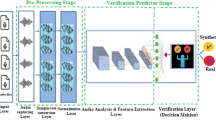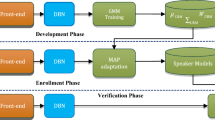Abstract
In order to solve the problem of leakage in biometrics, to improve the performance of speech retrieval and the security of single biometric template, this paper proposes a verifiable speech retrieval algorithm based on diversity security template and BioHashing. Firstly, both of biometrics which are the cross-correlation cosine and improved sub-band energy entropy ratio are fused to construct the time-frequency biometric vectors, finally the vectors are classified by the K-medoids algorithm. Then, the dimension vectors of the orthogonal set matrix which is constructed by Schmidt orthogonalization of the QCNN(Quantum Cellular Neural Network) chaotic matrix are one-to-one corresponding to the biometric vectors of the corresponding class to form the diversity biosafety templates, and the templates are further quantified to generate BioHashing sequences. Finally, the address index of dimension vectors of QCNN chaotic matrix and BioHashing sequences of corresponding class are one to one correspondingly encrypted by QCNN chaotic mapping encryption to construct hash index, and then the hash index is stored in the system hash index table of the cloud server. At the same time, the encrypted speech is uploaded to the cloud sever after 2D-LICM chaotic scrambling-shift encryption which is convenient to match and retrieve data for the users. Experimental results show that the diversity template has better security and complexity by using K-medoids algorithm to classify the biometric. Hash index and encrypted speech can effectively prevent the leakage of privacy data. At the same time, the retrieval system has better discrimination and retrieval performance, and it performs verifiable retrieval of speech for content preservation operations.


























Similar content being viewed by others
Data Availability
Raw data were generated at the large-scale facility. Derived data supporting the findings of this study are available from the corresponding author upon request.
References
Abdullahi SM, Wang H (2018) Robust enhancement and centroid-based concealment of fingerprint biometric data into audio signals. Multimed Tools Appl 77(16):20753–20782
Atighehchi K, Ghammam L, Barbier M, Rosenberger C (2019) Greyc-hashing: combining biometrics and secret for enhancing the security of protected templates. Fut Gener Comput Syst 101:819–830
Bernardini C, Marchal S, Asghar M R, Crispo B (2019) Privicn: privacy-preserving content retrieval in information-centric networking. Comput Netw 149:13–28
Bounhas I, Soudani N, Slimani Y (2020) Building a morpho-semantic knowledge graph for arabic information retrieval. Inf Process Manag 57(6):102124
Cao C, Sun K, Liu W (2018) A novel bit-level image encryption algorithm based on 2d-licm hyperchaotic map. Signal Process 143:122–133
Chen H, Wo Y, Han G (2018) Multi-granularity geometrically robust video hashing for tampering detection. Multimed Tools Appl 77(5):5303–5321
Davis JD, Winkielman P, Coulson S (2017) Sensorimotor simulation and emotion processing: impairing facial action increases semantic retrieval demands. Cogn, Affect, Behav Neurosci 17(3):652–664
Dong X, Jin Z, Jin Teoh A B, Tistarelli M, Wong K (2019) On the security risk of cancelable biometrics. arXiv:1910.07770
Gong C, Zhang J, Yang Y, Yi X, Zhao X, Ma Y (2020) Detecting fingerprints of audio steganography software. Forensic Sci Int: Rep 2:100075
Guo Y, Ding G, Liu L, Han J, Shao L (2017) Learning to hash with optimized anchor embedding for scalable retrieval. IEEE Trans Image Process 26(3):1344–1354
He S, Zhao H (2017) A retrieval algorithm of encrypted speech based on syllable-level perceptual hashing. Comput Sci Inf Syst 14(3):703–718
Jararweh Y, Al-Ayyoub M, Fakirah M, Alawneh L, Gupta BB (2019) Improving the performance of the needleman-wunsch algorithm using parallelization and vectorization techniques. Multimed Tools Appl 78(4):3961–3977
Kermanshahi SK, Liu JK, Steinfeld R, Nepal S (2019) Generic multi-keyword ranked search on encrypted cloud data. In: European symposium on research in computer security, pp 322–343. Springer
Li D, Deng L, Gupta BB, Wang H, Choi C (2019) A novel cnn based security guaranteed image watermarking generation scenario for smart city applications. Inf Sci 479:432–447
Li J, Di X, Liu X, Chen X (2017) Image encryption based on quantum-cnn hyperchaos system and anamorphic fractional fourier transform. In: 2017 10Th international congress on image and signal processing, biomedical engineering and informatics (CISP-BMEI). IEEE, pp 1–6
Li X, He D, Li J (2019) Parallel image search application based on online hashing hierarchical ranking. Clust Comput 22(1):1469–1478
Li Y, Ma J, Miao Y, Li H, Yan Q, Wang Y, Liu X, Choo K-KR (2021) Dvrei: dynamic verifiable retrieval over encrypted images. IEEE Trans Comput
Mafla A, Tito R, Dey S, Gómez L, Rusiñol M, Valveny E, Karatzas D (2021) Real-time lexicon-free scene text retrieval. Pattern Recognit 107656:110
Mohamed E, Elmougy S, Aref M (2019) Toward multi-lingual information retrieval system based on internet linguistic diversity measurement. Ain Shams Eng J 10(3):489–497
Nair S, Ragni A, Klejch O, Galušcáková P, Oard D (2020) Experiments with cross-language speech retrieval for lower-resource languages. Inf Retr Technol, pp 145–157
Nakazawa T, Kulkarni DV (2018) Wafer map defect pattern classification and image retrieval using convolutional neural network. IEEE Trans Semicond Manuf 31(2):309–314
Qin J, Liu X, Lin H (2015) Audio retrieval based on manifold ranking and relevance feedback. Tsinghua Sci Technol 20(6):613–619
Revathi B, Sudha GF (2018) Retrieval performance analysis of multibiometric database using optimized multidimensional spectral hashing based indexing. J King Saud Univ-Comput Inf Sci
Sengan S, Kamalam GK, Vellingiri J, Gopal J, Velayutham P, Subramaniyaswamy V et al (2020) Medical information retrieval systems for e-health care records using fuzzy based machine learning model. Microprocess Microsyst, p 103344
Singh R, Rai D, Prasad R, Singh R (2018) Similarity detection in biological sequences using parameterized matching and q-gram. In: 2018 recent advances on engineering, technology and computational sciences (RAETCS), pp 1–6. IEEE
Solainayagi P, Ponnusamy R (2019) Trustworthy media news content retrieval from web using truth content discovery algorithm. Cogn Syst Res 56:26–35
Tong Q, Miao Y, Chen L, Weng J, Liu X, Choo K-KR, Deng R (2021) Vfirm: verifiable fine-grained encrypted image retrieval in multi-owner multi-user settings. IEEE Trans Serv Comput
Tzelepi M, Tefas A (2018) Deep convolutional learning for content based image retrieval. Neurocomputing 275:2467–2478
Ushakov AV, Vasilyev I (2021) Near-optimal large-scale k-medoids clustering. Inf Sci 545:344–362
Wei Y, Zeng Y, Li C (2018) Single-channel speech enhancement based on subband spectral entropy. J Audio Eng Soc 66(3):100–113
Yang Y, Zheng X, Chang V, Ye S, Tang C (2018) Lattice assumption based fuzzy information retrieval scheme support multi-user for secure multimedia cloud. Multimed Tools Appl 77(8):9927–9941
Zarezadeh M, Mala H, Ashouri-Talouki M (2020) Multi-keyword ranked searchable encryption scheme with access control for cloud storage. Peer-to-Peer Netw Appl 13(1):207–218
Zhang Q-y, Ge Z-x, Hu Y-j, Bai J, Huang Y-b (2020) An encrypted speech retrieval algorithm based on chirp-z transform and perceptual hashing second feature extraction. Multimed Tools Appl 79(9):6337–6361
Zhang Q, Ge Z, Zhou L, Zhang Y (2019) An efficient retrieval algorithm of encrypted speech based on inverse fast fourier transform and measurement matrix. Turkish J Electrical Eng Comput Sci 27(3):1719–1736
Zhang Q-y, Hu W-j, Huang Y-b, Qiao S-b (2018) An efficient perceptual hashing based on improved spectral entropy for speech authentication. Multimed Tools Appl 77(2):1555–1581
Zhang Q-y, Li Y-z, Hu Y-j (2021) A retrieval algorithm for encrypted speech based on convolutional neural network and deep hashing. Multimed Tools Appl 80(1):1201–1221
Zhang Q-y, Li G-l, Huang Y-b (2020) An efficient retrieval approach for encrypted speech based on biological hashing and spectral subtraction. Multimed Tools Appl 79(39):29775–29798
Zhang Q, Li G, Qiao S-b, Zhang Y-b (2020) A safety and efficient speech biological hashing algorithm. J Comput 31(2):168–179
Zhang Q-y, Qiao S-b, Huang Y-b, Zhang T (2018) A high-performance speech perceptual hashing authentication algorithm based on discrete wavelet transform and measurement matrix. Multimed Tools Appl 77(16):21653–21669
Zhou K, Zeng J, Liu Y, Zou F (2018) Deep sentiment hashing for text retrieval in social ciot. Fut Gener Comput Syst 86:362–371
Acknowledgements
This work is supported by the National Natural Science Foundation of China(No.61862041), science and technology program of Gansu Province(No.21JR7RA120).
Author information
Authors and Affiliations
Corresponding author
Ethics declarations
Competing interests
The authors declare no competing financial interests.
Additional information
Publisher’s note
Springer Nature remains neutral with regard to jurisdictional claims in published maps and institutional affiliations.
Rights and permissions
Springer Nature or its licensor (e.g. a society or other partner) holds exclusive rights to this article under a publishing agreement with the author(s) or other rightsholder(s); author self-archiving of the accepted manuscript version of this article is solely governed by the terms of such publishing agreement and applicable law.
About this article
Cite this article
Zhang, Y., Huang, Yb., Chen, Dh. et al. Verifiable speech retrieval algorithm based on diversity security template and biohashing. Multimed Tools Appl 82, 36973–37002 (2023). https://doi.org/10.1007/s11042-023-14873-5
Received:
Revised:
Accepted:
Published:
Issue Date:
DOI: https://doi.org/10.1007/s11042-023-14873-5




